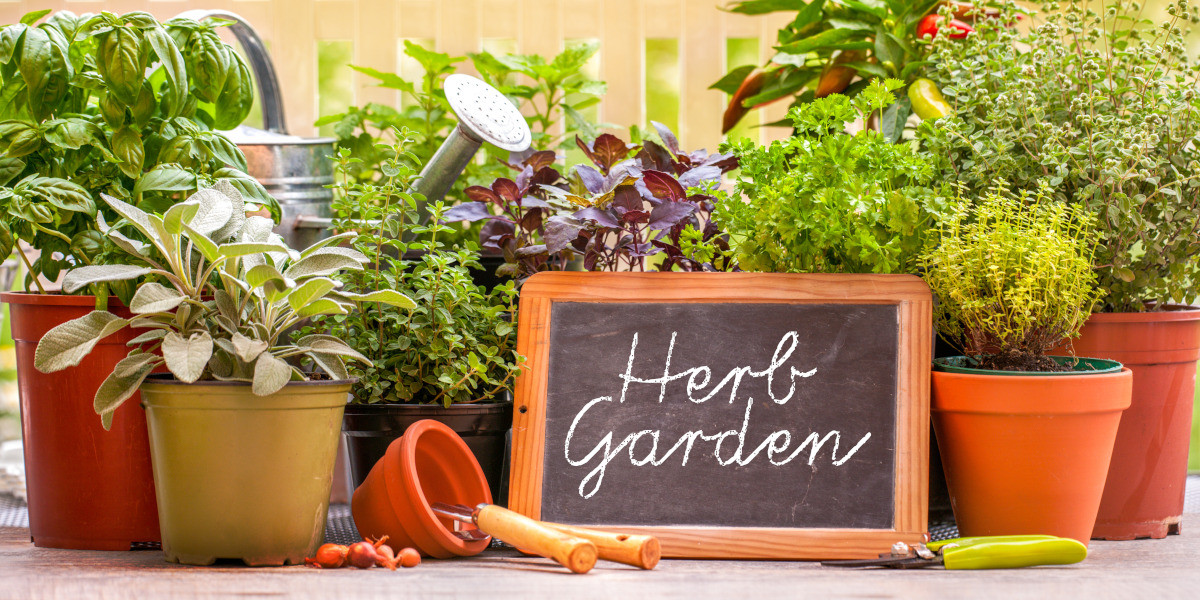A Beginner's Guide To Growing Herbs in Spring

Some of the herbs we all know and love, like thyme and rosemary, are native to coastal Mediterranean areas and the soil they prefer is sandy without too many nutrients. They seem to thrive on neglect. French tarragon is similar, so it does not need very rich soil. It just needs to drain well. However, there are choosier herbs that prefer more nutrients and homemade compost, like basil, chives, and coriander (Cilantro US). Parsley, peppermint, chives, and sage all seem typically British and have been used for centuries in cooking but there are some less well-known herbs like Lovage that used to grow in monastery gardens and this is an unusual one to try.
For a school garden, herbs are perfect if you can allow the rain to water them during school holidays and the perennial ones will still be happily growing on the return to school in September.
How to plant and care for herbs.
Annual means that they last just for one season - you sow seeds for new plants every year and then they die off in the autumn. Most annual herbs love rich soil and lots of sunshine - basil, chives, coriander, garlic, and parsley. These herbs like to be watered a lot and if you don’t, they will try to flower and go to seed. These herbs do not like frost or cold so only plant them outside when the summer has arrived and the air is warm from May onwards.
Perennial herbs last for many years. Bush-type herbs like sage, rosemary, thyme, and lavender come back year after year. They prefer soil that is not so rich and they do not mind being in the shade for a part of the day either. These are fine with cold winter weather too. Allow these bigger herbs some space so they can grow into a bush. These are best placed at the back of the herb bed with the smaller annual herbs in front of them.
5 Non-frost hardy herbs
1. Basil
Basil needs warm temperatures and soil to germinate and does not tolerate frost. Sow seeds indoors from April onwards and place the pots on a sunny windowsill. Cover with a polythene bag to keep heat in. Once seedlings appear, continue to water every 2 days or if the soil seems dry. Dig them into the ground outside once the last frost is gone. Pick leaves regularly or this herb flowers and goes to seed. Remove the white flowers and eat them! Children can pick leaves as they wander around or they can make pesto with an adult to supervise.
2. Coriander (Cilantro (US)
For both leaves and seeds. This has a sweet taste for summer salads or Italian cooking. Spread a handful of seeds in a pot, water them, and then keep them warm until the seedlings show. Water them well when you dig them into the soil or they try to go to seed. You can eat the leaves and the seeds are used in Indian cooking, adding sweetness to any dish.
3. Chives
Chives are extremely easy to grow and can be chopped into boiled eggs or added to salads. They are hardy once they have been in the ground for a full year but to start them off, sow the tiny black seeds in late spring and do not plant on a windy day! They have an oniony taste and look quite decorative when their flowers arrive, showing purple round blooms. Bees love them too. Give them rich soil, plant them in pots, and add them outside to your herb bed, after the risk of frost is gone. These are often the first herbs to pick in spring.
4. Parsley
Parsley comes in 2 main types; moss curled or flat-leaved. It is often used as a garnish on food and is fantastic in parsley sauce or you can just munch a few leaves as you garden. It is a very difficult seed to get started though. The soil needs to be warm and moist, so start them inside in pots, and cover them with a bag until they show. Be very patient too because it may take 3 weeks and a burst of sunshine before the seedlings appear. Plant them outside from May onwards in a location where they catch the sun all day long.
5. Lovage
If you want to try an unusual herb, try Lovage. It produces a long stalk with lots of leaf foliage and you can happily place this in an ornamental flower bed as well as the herb bed. The taste is difficult to describe. It is somewhat similar to celery but fresh and distinctive and adds great flavour to a summer salad or fish. You can grow it from seed or buy a plant in your local gardening store. It loves rich soil, but will not tolerate frost so as soon as the weather gets cold, dig it up and put it in a pot over the winter so that you can plant it outside next year. It doesn’t need to be watered over the winter but as soon as spring sunshine hits the pot, a green stalk appears and your Lovage is back.
5 Frost-hardy Herbs
All these herbs start off very small but can grow into huge bushes, if you allow them some room to spread. Plant them at least a foot (30 cm) apart. They will last for many years in the garden and apart from lavender, they can be eaten fresh or dried. The soil does not need to be too rich and they can tolerate some shade too.
6. Garlic
Garlic is fantastic to show young growers how nature transforms a single clove into a full bulb in a few months. These can be planted in September at the start of a school year and will grow happily outside or you can plant them later, when starting your herb garden. They need rich soil and you can water them generously and watch the faces when they harvest a full garlic clove. It is a healthy addition to many recipes and is recommended for tasty recipes like garlic bread.
7. Lavender
Lavender is grown for its fabulous smell and oil pressed from the flowers can be used to relax muscles in the bath, or to soothe sore skin. Its spikes of purple flowers are adored by bees and butterflies too. You can cut bunches of flowers to dry and hang them in your classroom or add them to lavender bags to retain that fresh smell in drawers of clothes or put one under a child’s pillow to help them sleep better.
8. Thyme
Thyme is a ground-hugging plant that spreads sideways. It can be eaten fresh, added to stuffings or soups, and some people drink tea made with fresh or dried leaves. It grows in dry settings where rainfall is not frequent so don’t overwater it. It has lovely pink flowers during the summer adding to its charm.
9. Rosemary
Rosemary is grown for its distinctive leaves but its blue flowers look gorgeous in any flower garden in early spring too. Bees adore it and butterflies will visit these flowers too. “Rosemary for remembrance” goes the old saying, and it seems that current medical research confirms that regular consumption may improve memory function. Use it sparingly because it is strong. It is probably best bought as a small shrub or from a cutting, where you snip a branch and then root that in water. Plant it into the soil outside when the root shows.
10. Sage
Sage is perfect for adding to stuffing or as flavouring for casseroles and soups and I like to eat the odd leaf or two as I wander around because experts tell me it regulates hormones and is widely used by ladies of all ages for this purpose. It does not grow well close to other herbs because its roots emit a substance that inhibits growth. However, sage is fantastic next to strawberries, borage, and bees and butterflies flock to its flowers so it is perfect for a cottage garden.
Conclusion
So it is time to get sowing seeds for all these herbs and hope the frost has gone for good so we can really get out there in the next few weeks. We have briefly touched on bees and the pollinators that these herbs attract, and next week I will be looking at methods of attracting bees by providing pollen so that your vegetable garden will be buzzing this summer. Feeding the hoverflies, bees, and butterflies means our vegetable plants will get pollinated too.


